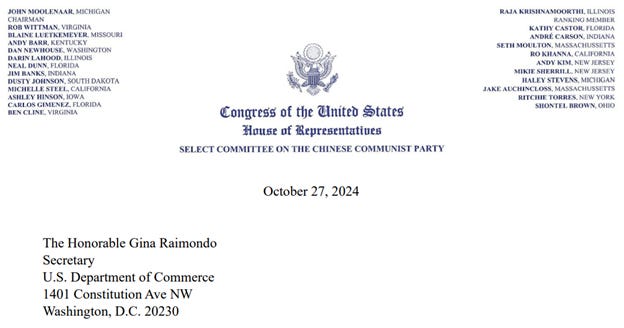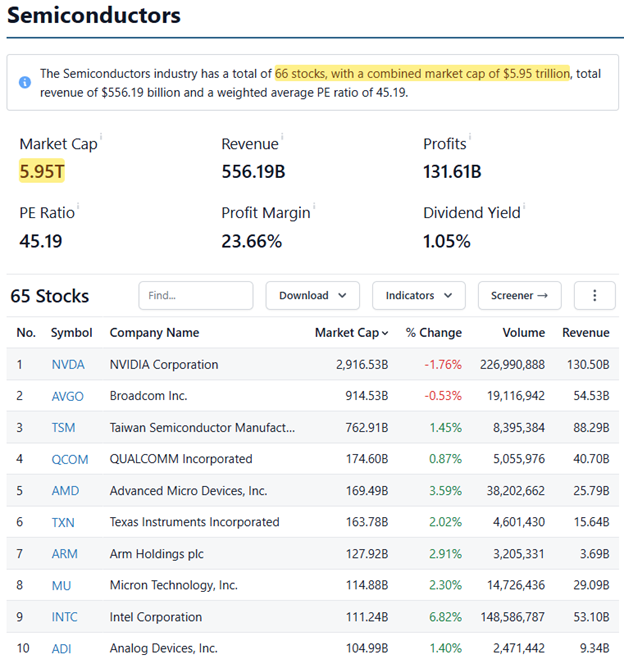China is "changing lanes" and winning on all fronts in the Chip War
Bullets:
Chinese labs are achieving breakthroughs in silicon photonics, materials engineering, and even by revolutionizing the shape of semiconductors themselves.
The latest advances include first-ever successful tests of new photon chips, which use light instead of electrons.
Several Chinese labs are now moving to the mass production phases of photonic silicon chips, which will result in magnitudes of improvements over traditional silicon.
Other laboratories report success by getting rid of silicon altogether. A new technique involving a bismuth compound and a 2-dimensional chip design is 40% faster than the fastest 3-nanometer silicon chips, with a 10% improvement in energy efficiency besides. That technology is also to be mass produced.
These developments raise disturbing questions as to the valuations of the companies in our semiconductor industry, worth a combined market cap of nearly $6 trillion. Are they building the next generation of superfast semiconductors? Or will it be China?
Report:
Good morning. I don’t understand any of the articles or research papers we’re linking to today. So if in the next few minutes you feel the urge to go to the comment section and say that this guy doesn’t seem to know much about semiconductors, I’ll save you the trouble. I’m already aware.
And it’s one reason why so many of our videos are about 10 minutes, instead of an hour and ten. But it does seem that many of the breakthroughs that are coming out of Chinese labs are guaranteed to put some of our biggest companies out of business, given time. And not a lot of time.
This is a letter from a select committee of the US Congress, to Gina Raimondo. She was the Commerce Secretary during the Biden Administration. Note the date, 27 October of last year. In the letter, Congressmen are asking Commerce Department to “include silicon photonics equipment and products” on our semiconductor sanctions list for China. “Silicon phonics is the next front in the semiconductor competition” with China, and the United States is currently “not winning.” Preventing US investment and know-how and supporting domestic innovation, though, will “ensure continued American leadership in silicon photonics and other critical emerging technologies.”
The concern here is that semiconductor manufacturers are bumping up hard now against the physical limitations of making ever-smaller computer chips using silicon. So they’re looking for new solutions, new materials and technologies that can get around these limitations, and photonics is one of those approaches. Photonics is using light instead of electrons, and insiders believe that photonic chips will represent monumental improvements in speed and performance, a 1000-times increase.
Their other concern is that China is already heading that way, and Chinese officials have said so, publicly. China hopes to change lanes and jump ahead of the US just by using different materials altogether.
In photonics, Chinese labs are already making big strides. This is news from a lab in Wuhan, where researchers claim to have achieved a milestone in silicon photonics, which could help China overcome the limitations of current chip design, and become self-sufficient in semiconductors despite US sanctions. But note the date stamp on this one: 6 October 2024. So this article dropped on October 6, and exactly 3 weeks later Congress tells Commerce that we need to close the door on our silicon photonics technology or China might one day be able to build light-based chips.
Moving on. JFS Laboratory used laser light source on a silicon chip, for the first time in China. Here again, they explain the problem that we’re nearing the limits of what’s possible using electrons, so they’re moving to light particles, photons, instead.
This Wuhan lab is just one of several in China who are pushing into silicon photonics. And other global companies are in the race too. TSMC believes that photonics integrated with silicon will be a paradigm shift in the industry. Nvidia and Intel, Huawei—so these are big companies with big money all working on the photonic chips.
But the advances will probably happen in China faster than elsewhere, China is being forced to innovate around the import bans of EUV machines used to make the traditional silicon chips. In contrast, photonics chips can be built domestically—in China that is—using older equipment and materials. Here’s the money quote: China is being hindered in the manufacture of the traditional silicon chips, so they are motivated to devote a lot more resources to the next-generation semiconductors.
So that’s some of what China’s doing in photonic chips—light particles on silicon chips. Other Chinese labs are also getting away from silicon altogether, and using different materials and new shapes to design chips. Here they use the term changing lanes again, and they’ve built the fastest-ever chip using bismuth oxyselenide, instead of silicon. Their research path was born of necessity, and the need to get around all the silicon-based technologies that are on the sanctions lists. This team from Peking University built a 2-dimensional transistor—it’s super-flat—that is 40 percent faster than our fastest 3-nanometer chips, and consumes less energy besides. Using different materials is a shortcut, but using different materials with a 2D design is changing lanes, is how the lead researcher explains things.
Their research was built using stuff they already had sitting around, they just needed to think about the tech in a new way. They built what’s called a GAAFET to get around the physical limitations of silicon. 40% faster at 10% energy savings. Now they’re moving to the mass production phase, betting that this is a smarter way forward than building devices for silicon chips.
This was the abstract the group published in Nature about a year ago, where they explained their strategy to build their 2-dimensional semiconductor.
And a different Chinese research team last month, February, explains how 2D bismuth oxyselenide in different chemical combinations are strong alternatives to silicon chips. The compound used by the team at Peking University has outstanding photoresponse performance across different light spectra.
Here is a summary from Trendforce, and this one also predates the Congressional letter to lock the barn door after the horses are gone and China blows past our chip sanctions again. September 2024 for this one from Trendforce. Jiaotong University in Shanghai launched a photonic chip pilot line in Wuxi, with expectations to build 10,000 wafers a year, beginning now.
Jinan, in Shandong province, mass production of lithium niobate crystals, ramping up eventually to 250,000 per year of whatever those are.
Lithium tantalate wafers used here with photonic chips, those guys are in Shanghai.
Tsinghua University in Beijing with the Taiji 2 optical training chip for neural networks in optical computing systems. And here’s Peking University again, with world’s first fully programmable optical artificial atomic lattice.
This is how Chinese solve problems, then, by throwing a lot of very smart people in a lot of places at a problem, lock them in a room and tell them not to come out until you guys have solved the dynamic topological phase transitions problems with multiple lattice insulators. See you in a few months.
And this is apparently how we respond to Chinese solving problems: Our lawmakers who don’t understand any of these technologies either, read about what Chinese labs have already done, then they send a letter to our Commerce Department and say we need to lock up our technologies that the Chinese didn’t even use. It’s performance art now, the clown show that we put on to pretend this is what our China containment policy is.
This is DeepSeek, squared. DeepSeek blew up our markets when we learned that a hundred kids in Hangzhou with 6 million dollars built a large language model that was as good as the ones we’ve got that cost 1000 times more.
What happened here though? Is it true that these five guys, right here—that kid in the front doesn’t look like he’s old enough to even drive. They looked around their lab, found some bismuth, and tried to make a semiconductor. Nah, that didn’t work.
Well let’s make it super flat, like a pancake that’s one atom thick. Oh, look. It’s working. And it’s 40% faster, too. What’s our plan for that, when these guys are given some more money and some more people?
And what will the reaction on Wall Street be to that, when Chinese foundries are mass-producing semiconductors based on silicon photonics and bismuth oxyselenide?That’s not a rhetorical question—it is literally a $6 trillion dollar question:
DeepSeek wiped out hundreds of billions in shareholder equity when we learned that strong AI models can be built using older semiconductors, and so the demand for the cutting-edge semiconductors isn’t as high as we thought. But DeepSeek is software. This is hardware, and if these Chinese here are right, our companies are building semiconductors wrong.
Resources and links:
Letter from Congressional Select Subcommittee to Secretary of Commerce re: China’s Photonics Industry
Chip war: China claims breakthrough in silicon photonics that could clear technical hurdle
China claims silicon photonics breakthrough to overcome major chip hurdle
https://interestingengineering.com/innovation/china-silicon-photonics-chip-breakthrough
‘Changing lanes’: China heralds fastest-ever chip technology – without silicon
[News] China’s First Photonic Chip Pilot Line Launched, Along with Various Pioneering Research Achievements
Integrated 2D multi-fin field-effect transistors
https://www.nature.com/articles/s41467-024-47974-2
American Chemical Society, Nanolayered Bismuth Oxyselenide for Field-Effect Transistors and Photodetectors
https://pubs.acs.org/doi/10.1021/acsanm.4c07065
Semiconductors
https://stockanalysis.com/stocks/industry/semiconductors/







"Never interrupt your competitor when (s)he is making a mistake." — Napoleon Bonaparte (Chinese version)
Great article.
I am a retired PhD chemist semiconductor process engineer.
They have stolen so much for so long, and have learned how to innovate. I don't see how we are going to compete going forward.
Too late?🤔